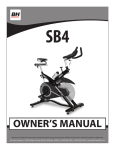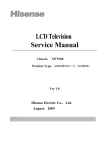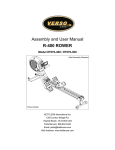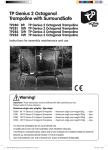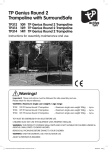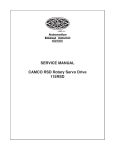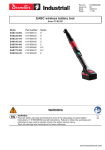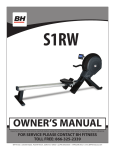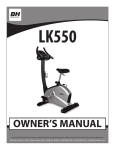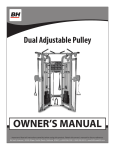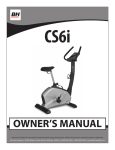Download BH FITNESS R8 - V3 Owner`s manual
Transcript
OWNER’S MANUAL Important: Read all instructions carefully before using this product. Retain this owner’s manual for future reference. BH North America | 20155 Ellipse, Foothill Ranch, California 92610 | p.949.206.0330 | f.949.206.0013 | www.BHFitnessUSA.com TABLE OF CONTENTS TitlePage Introduction03 Warnings and Labels04 Safety Information05 Exercise Instruction06 Training Guidelines07 Workout and Stretching11 Overview13 Assembly Instructions14 Console Overview20 Console Operations21 Exploded View Drawing27 Parts List28 Warranty29 CONGRATULATIONS Congratulations on your purchase of BH Fitness equipment. We hope you appreciate the style, quality, and value that exercisers around the world have come to expect from BH Fitness. If you have any questions, concerns or product issues, please call our Customer Service Team at 1-866-325-2339 or email us at [email protected]. Carefully read through the instructions contained in this manual. They provide you with important information about assembly, safety, fitness and use of the vibration machine. Please read ALL the safety information contained in the following pages. 3 WARNINGS AND LABELS Keep hands and fingers clear of this area. 4 SAFETY INFORMATION PRECAUTIONS This rower has been designed and constructed to provide maximum safety. Nevertheless, certain precautions should be taken when using exercise equipment. Read the whole manual before assembling and using the rower. Please observe the following safety precautions: 1. Keep children and pets away from this equipment at all times. DO NOT leave them unsupervised in the room where the rower is kept. 2. If you experience dizziness, nausea, chest pains or any other symptom while using this rower STOP the exercise. SEEK IMMEDIATE MEDICAL ATTENTION! 3. Use the rower on a level and solid surface. Adjust the feet for stability. 4. Do not place hand or objects in or near any openings. 5. Wear clothing suitable for doing exercise. Do not wear baggy clothing. Always wear athletic shoes when using the rower and tie the laces securely. 6. This rower must only be used for the purposes described in this manual. DO NOT use accessories that are not recommended by BH Fitness. 7. Do not place sharp objects near the rower. 8. Do not use the rower if it is not working correctly. 9. Before using the rower, thoroughly inspect the equipment for proper assembly. 10.Keep a clear perimeter of 3 feet (1 meter) around the rower before operating the equipment. 11.Use only authorized and trained technicians if a repair is needed. 12.Please follow the advice for correct training, as detailed in the Training Guidelines. 13.Use only the tools provided to assemble this rower. 14.This rower was designed for a maximum user weight of 325 lbs (148 kgs). 15.The rower can only be used by one person at a time. 16.Do not use this rower outside. 17.Do not use the rower if the main electrical cord becomes damaged or worn. Keep the main electrical cord away from hot surfaces. Caution: Consult your doctor before beginning to use the machine or any exercise program. Read all of the instructions before using any exercise equipment. KEEP THESE INSTRUCTIONS SAFE FOR FUTURE USE. 5 EXERCISE INSTRUCTION Use of the rower offers various benefits; it can improve fitness, muscle tone, flexibility and circulation. When used in conjunction with a calorie controlled diet, it can help you lose weight. 1. Consult your doctor before starting any exercise program. It is advisable to undergo a complete physical examination. 2. Exercise at recommended level. Do not over exert yourself. 3. If you feel any pain or discomfort, stop exercising immediately and consult your doctor. 4. Wear appropriate clothing and footwear for the exercise; do not wear baggy clothing; do not wear leather soled shoes or high heels. 5. Get on to the equipment slowly and securely. 6. Select the program or workout option that is most closely aligned with your workout interests. 6 TRAINING GUIDELINES Exercise is one of the most important factors in the overall health of an individual. Listed among its benefits are: • Increased capacity for physical work (strength endurance) • Increased cardiovascular (heart and arteries/veins) and respiratory efficiency • Decreased risk of coronary heart disease • Changes in body metabolism, e.g. losing weight • Delaying the physiological effects of age • Reduction in stress, increase in self-confidence, etc. There are several components of physical fitness and each is defined below. STRENGTH The capacity of a muscle to exert a force against resistance. Strength contributes to power and speed. MUSCULAR ENDURANCE The capacity to exert a force repeatedly over a period of time, e.g. it is the muscular endurance of your legs to carry you 10 km without stopping. FLEXIBILITY The range of motion of your joints. Improving flexibility involves the stretching of muscles and tendons to maintain or increase suppleness, and it provides increased resistance to muscle injury or soreness. CARDIO-RESPIRATORY ENDURANCE The most essential component of physical fitness. It is the efficient functioning of the heart and lungs. AEROBIC FITNESS Is an exercise of relatively low intensity and long duration, which depends primarily on the aerobic energy system. Aerobic means "with oxygen", and refers to the use of oxygen in the body's metabolic or energy-generating process. Many types of exercise are aerobic, and by definition are performed at moderate levels of intensity for extended periods of time. ANAEROBIC TRAINING Is an exercise intense enough to trigger anaerobic metabolism. This means “without oxygen” and is the output of energy when the oxygen supply is insufficient to meet the body’s long term energy demands. (For example, a 100 meter sprint.) 7 OXYGEN UPTAKE The effort that you can exert over a prolonged period of time is limited by your ability to deliver oxygen to the working muscles. Regular vigorous exercise produces a training effect that can increase your aerobic capacity by as much as 20 to 30%. An increased VO2 Max indicates an increased ability of the heart to pump blood, of the lungs to ventilate oxygen, and of the muscles to take up oxygen. THE TRAINING THRESHOLD This is the minimum level of exercise which is required to produce significant improvements in any physical fitness parameter. OVERLOAD This is where you exercise above your comfort level. The intensity, duration and frequency of exercise should be above the training threshold and should be gradually increased as the body adapts to the increasing demands. As your fitness level improves, the training threshold should rise. Working through your program and gradually increasing the overload factor is important. PROGRESSION As you become more fit, a higher intensity of exercise is required to create an overload and therefore provide continued improvement. SPECIFICS Different forms of exercise produce different results. The type of exercise that is carried out is specific to the muscle groups being used and to the energy source involved. There is little transfer of the effects of exercise, i.e. from strength training to cardiovascular fitness. That is why it is important to have an exercise program tailored to your specific needs. REVERSIBILITY If you stop exercising or do not do your program often enough, you will lose the benefits you have gained. Regular workouts are the key to success. WARM-UP Every exercise program should start with a warm-up where the body is prepared for the effort to come. It should be gentle and preferably use the muscles group to be involved later. Stretching should be included in both your warm-up and cool down, and should be performed after 3-5 minutes of low intensity aerobic activity or calisthenic type exercise. WARM DOWN OR COOL DOWN This involves a gradual decrease in the intensity of the exercise session. Following exercise, a large supply of blood remains in the working muscles. If it is not returned promptly to the central circulation, pooling of blood may occur in the muscles. 8 HEART RATE As you exercise, your heart beat increases. This is often used as a measure of the required intensity of an exercise. You need to exercise hard enough to condition your circulatory system, and increase your pulse rate, but not enough to strain your heart. Your initial level of fitness is important when developing an exercise program for you. When starting, you can get a good training effect with a heart rate of 110-120 beats per minute (BPM). If you are more fit, you will need a higher threshold of stimulation. To begin with, you should exercise at a level that elevates your heart rate to about 65 to 70% of your maximum. If you find this is too easy, you may want to increase it, but it is better to lean on the conservative side. As a rule of thumb, the maximum heart rate is 220 minus your age. As you increase in age, your heart, like other muscles, loses some of its efficiency. Some of its natural loss is won back as fitness improves. The following table is a guide to those who are “starting fitness.” Age Target Heart Rate 25 3035404550556065 10 Second Count 23 2222212019191818 Beats per Minute 138 132 132 126 120 114 114 108 108 PULSE COUNT The pulse count (on your wrist or carotid artery in the neck, taken with two index fingers) is done for ten seconds, taken a few seconds after you stop exercising. This is for two reasons: (a) 10 seconds is long enough for accuracy, (b) the pulse count is to approximate your BPM rate at the time you are exercising. Since heart rate slows as you recover, a longer count isn’t as accurate. The target is not a magic number, but a general guide. If you’re above average with your fitness, you may work comfortably a little above that suggested for your age group. The following table is a guide. Age Target Heart Rate 25 3035404550556065 10 Second Count 262625242322222120 Beats per Minute 156156150144138132132126120 Don’t push yourself too hard to reach the figures on this table. It can be very uncomfortable if you over exercise. Let it happen naturally as you work through your program. Remember, the target is a guide, not a rule, a little above or below is just fine. Two final comments: (1) don’t be concerned with day to day variations in your pulse rate, being under pressure or not enough sleep can affect it; (2) your pulse rate is a guide, don’t become a slave to it. 9 MUSCLE SORENESS For the first week or so, muscle soreness may be the only indication you have that you are on an exercise program. This, of course, does depend on your overall fitness level. A confirmation that you are on the correct program is a very slight soreness in most major muscle groups. This is quite normal and will disappear in a matter of days. If you experience major discomfort, you may be on a program that is too advanced, or you have increased your program too rapidly. If you experience PAIN during or after exercise, your body is telling you something. Stop exercising and consult your doctor. WHAT TO WEAR Wear clothing that will not restrict your movement in any way while exercising. Clothes should be light enough to allow the body to cool. Excessive clothing that causes you to perspire more than you normally would gives you no advantage. The extra weight you lose is body fluid and will be replaced with the next glass of water you drink. It is advisable to wear a pair athletic shoes. BREATHING DURING EXERCISE Do not hold your breath while exercising. Breathe normally as much as possible. Remember, breathing involves the intake and distribution of oxygen, which feeds the working muscles. REST PERIODS Once you start your exercise program, you should continue through to the end. Do not break off halfway through and then restart at the same place later on without going through the warm-up stage again. The rest period required between exercises may vary from person to person. 10 SUGGESTED STRETCHES Head Rolls Rotate your head to the right for one count while feeling the stretch up the left side of your neck. Next, rotate your head back for one count, stretching your chin to the ceiling. Rotate your head to the left for one count, and finally, drop your head to your chest for one count. Shoulder Lifts Lift your left shoulder up toward your ear for one count. Then lift your right shoulder up for one count as you lower your left shoulder. Side Stretches Open your arms to the side and continue lifting them until they are over your head. Reach your left arm as far upward as you can for one count. Feel the stretch up your left side. Repeat this action with your right arm. Quadriceps Stretch With one hand against a wall for balance, reach behind you and pull your left foot up. Bring your heel as close to your buttocks as possible. Hold for 15 counts and repeat with right foot up. 11 SUGGESTED STRETCHES Inner Thigh Stretch Sit with the soles of your feet together with your knees pointing outward. Pull your feet as close into your groin as possible. Gently push your knees towards the floor. Hold for 15 counts. Toe Touches Slowly bend forward from your waist, letting your back and shoulders relax as you stretch toward your toes. Reach down as far as you can and hold for 15 counts. Hamstring Stretches Sit with your right leg extended. Rest the soles of your left foot against your right inner thigh. Stretch toward your toes as far as possible. Hold for 15 counts. Relax and then repeat with left leg extended. Calf/Achilles Stretches Lean against a wall with your right leg in front of the left and your arms forward. Keep your left leg straight and the right foot on the floor; then bend the right leg and lean forward by moving your hip toward the wall. Hold, then repeat on the other side for 15 counts. 12 OVERVIEW 13 ASSEMBLY INSTRUCTIONS FIGURE 1 STEP 1: Remove Components Remove the components. Lay the machine and packaging on the floor as shown in Figure 1. Remove the components D & E from inside the polyfoam as shown and set aside for further assembly. Replace the polyfoam blocks in their original positions. Flip the packaged assembly up 90 degrees as shown in Figure 2. D E polyfoam FIGURE 2 STEP 2: Front Stabilizer Assembly Place the front stabilizer (B) onto the main frame and tighten into place using 4 screws (J1) and 4 washers (J2). B A POLYFOAM(1) J2 J1 POLYFOAM(2) 14 USE TOOL STEP 3: Pedal Connection Tube Assembly Flip the main frame over so it rests on the stabilizer as shown below. Remove the polyfoam blocks and set aside. Install the Pedal Connection Tube (G) to the main frame (A) using 4 screws (J1) **Before pulling the rope for exercise, it is necessary to remove the strap holder first (see inset) POLYFOAM(4) FIGURE 3 POLYFOAM(3) STRAP HOLDER J1 A A G STEP 4: Assemble Saddle With Upper Slide Track Install the Saddle (E) onto the Upper Slide Track (D) using 4 screws (J1 as shown. Then using 6 screws (J1), attach the Upper Slide Track (D) with the Main Frame (A) FIGURE 4 15 STEP 5: Assemble the Rear Stabilizer Lift the Upper Slide Track (D) off the ground and fit the Rear Stabilizer (C) into place. Use 6 Screws (J1) to tighten the Rear Stabilizer (C) into place on the Upper Slide Track (D) FIGURE 5 STEP 6: Pedal Assembly and Adjustment Slide the Right Pedal (F1) onto the Pedal Connection Tube (G). Use 1 screw (J1) and 1 washer (J2) to secure it in place. For Pedal adjustment loosen the nut (F10) and the knob (F9), move pedal to desired position and retighten the nut (F10) and knob (F9). Repeat steps for Left Pedal assembly and Adjustment. **IMPORTANT** Be sure to install pedals on the correct side so that the heel cup is at the back of the pedal as shown. Otherwise you will experience slipping and could fall out of the pedals. FIGURE 6 16 STEP 7: Folding the Machine for Storage It is advised that two people perform the following steps to prevent injury. Loosen the knob (A4) then pull it down. Fold the Slide Track up as shown, then retighten the knob. IMPORTANT: Hold the Slide Track in the upright position until it is confirmed that the knob (A4) has been tightened completely. Failure to do so could cause risk of injury. To unfold for use, simply reverse these steps, using two people for safety. It is highly recommended for two people to fold and unfold to prevent injury. FIGURE 7 STEP 8: Power Considerations Take consideration to place the machine near a power outlet. Plug the power adapter into the outlet and the adapter cord into the plug on the machine as shown. FIGURE 8 17 STEP 9: How to Move the Machine The front stabilizer has built-in wheels for convenience. Stand at the front of the machine and lift until the weight of the machine shifts to the transportation wheels. The machine is now ready to be moved to a new location. When moving the rowing machine, please make sure the wheels are moving across a level surface. STEP 10: Console and Pedal Strap Adjustment The console angle is adjustable as shown. Retighten once desired position is found using the 8mm tool. STEP 11: Pedal Strap Adjustment Put foot into pedal (F1) and tighten the strap (F13) Repeat for the other side pedal strap adjustment. 18 Tighten the Pedal Strap (F13) securely after you have found a position that is just right for you. STEP 12: Slide Adjustment There are 3 screws (E9 x 1 and E3 x 2) under the Saddle as shown below. Loosen the middle screw (E9) then adjust the other 2 screws (E3) to loosen or tighten the sliding action of the saddle based upon personal preference. After you are comfortable with your settings, lock them into place by tightening the middle screw (E9) TOOL 5M E3 E1 E9 E3 E D 19 CONSOLE OVERVIEW Function Control Mode Time/Time 500M Programs Stroke/Total Strokes User Data Reset Up Start/Stop Down Recovery Enter Distance Watt/Calories H.R.C. (Target Heart Rate) SPM Main Display 20 CONSOLE OPERATIONS QUICK START Once the rowing machine has been turned on, press the START/STOP button to begin your workout in MANUAL mode. If you need to reset the rower, press the reset key for 2 seconds. PROGRAM MODE After pressing the reset button for 2 seconds to restart the machine, use the UP/DOWN buttons to set up your user data by selecting any option between U0-U4. Please enter your GENDER / AGE / HEIGHT / WEIGHT then press ENTER to confirm. Then select MANUAL / PROGRAMS / WATT / USER / HRC / RACE. Follow the instruction below in regards to MANUAL / PROGRAMS / WATT / USER / HRC / RACE. MANUAL To access Manual Mode, follow the steps in the diagram below. 21 PROGRAM To access Program Mode, follow the steps in the diagram below. PRESS RESET 3SEC. TO RESET USER SELECT U0-U4 SELECT SEX OF MALE OR FEMALE UP UP DOWN PRESS ENTER PRESS UP OR DOWN UP PRESS ENTER DOWN UP PRESS ENTER DOWN PRESS UP OR DOWN UP SELECT USER SELECT RACE PRESS ENTER DOWN PRESS UP OR DOWN PRESS ENTER DOWN PRESS UP OR DOWN 22 SELECT CALORIES UP DOWN PRESS UP OR DOWN DOWN SELECT P8=> L1-L8 SELECT P3=> L1-L10 SELECT P9=> L1-L10 SELECT P4=> L1-L8 SELECT P10=> L1-L8 SELECT P5=> L1-L8 SELECT P11=> L1-L10 SELECT P6=> L1-L10 SELECT P12=> L1-L7 SELECT STROKES UP UP PRESS ENTER PRESS ENTER PRESS UP OR DOWN SELECT P7=> L1-L10 SELECT P2=> L1-L10 PRESS UP OR DOWN SELECT PULSE UP PRESS ENTER SELECT P1=> L1-L12 DOWN PRESS UP OR DOWN SELECT DISTANCE UP UP PRESS ENTER SELECT H.R.C SELECT TIME DOWN PRESS UP OR DOWN SELECT LOAD SELECT WATT DOWN PRESS ENTER PRESS UP OR DOWN SELECT PROGRAM PRESS ENTER UP DOWN PRESS UP OR DOWN SELECT MANUAL UP SELECT WGT SELECT HGT SELECT AGE DOWN PRESS UP OR DOWN PRESS START/STOP DOWN PRESS UP OR DOWN PRESS ENTER WATTS CONSTANT To access Watts Mode, follow the steps in the diagram below. 23 USER To access User Mode, follow the steps in the diagram below. 24 H.R.C. HEART RATE CONTROL - Select your own target Heart Rate by choosing from one of the preset programs: 55%, 75%, or 90%. Please enter you age into the User Data to ensure that your target Heart Rate is set correctly. The words "HEART RATE" will flash when you have reached your target heart rate according to the program that you have chosen. I. II. III. IV. 55% - Diet Program 75% - Health Program 90% - Sports Program TAG - User Set Target Heart Rate 25 RECOVERY When you have finished your workout, press RECOVERY. For this function to operate properly, you must wear a wireless Heart Rate chest strap. TIME will countdown from 1 minute and then your fitness from F1 to F6 will be displayed. Note: During recovery no other displays will operate. Score F1 F2 F3 F4 F5 F6 Condition Excellent Good Average Fair Poor Very Poor Heart Rate (From test HR minus end HR) Above 50 40-49 30-39 20-29 10-19 under 10 5.7 - RACE Press UP/DOWN button to adjust SPM and DISTANCE or PC. Press start to begin the race distance, the result is WIN or USER LOSE. 26 EXPLODED VIEW DRAWING 27 PARTS LIST To order replacement parts: provide your customer service representative with the product model number and the part number located on the Parts List below, along with the quanity you require. 28 NO. A A1 A2 A3 A4 A5 A6 A7 A8 A9 A10 A11 A12 A13 A14 A15 A16 A17 A18 A19 A20 DESCRIPTION MAIN FRAME SWIVEL AXIS TRANSPORTATION WHEEL BUSH KNOB FEET END CAP SCREW M8*16 SCREW M6*10 SCREW 5/32"*1/2" SCREW M6*90 NUT M6 CONSOLE TUBE SCREW 3/8"*3 3/4"* BUSH °Ì38*3/8 NUT 3/8 PLASTIC PULLEY NUT 3/8*26(UNF) NUT 3/8*26(UNF) BELT 350J6 PULLEY TENSION BELT QTY 1 1 2 2 1 2 2 2 8 1 1 1 2 4 2 1 2 2 1 1 1 NO. A53 A54 A55 A56 A57 A58 A59 A60 A61 A62 A63 B B1 B2 B3 B4 B5 B6 B7 C C1 DESCRIPTION FIX PLATE OF FRONT STABILIZER AXLE °Ì12*39 SCREW M6*12 BLOCK PLATE OF SLIDE TRAIL 20*60*4TPLATE BUMPER NUT M6 BRACKET SCREW M6*40 RUBBER STINGER BOLT M4*10 FRONT STABLILZER END CAP END CAP TRANSPORTATION WHEEL BOLT M8*40 NUT M8 WASHER M10*2 ADJUSTABLE FOOT REAR POST REAR STABLILZER QTY 1 12 4 2 2 4 2 2 2 2 4 1 2 2 2 2 2 4 4 1 1 A21 A22 A23 A24 A25 A26 A27 A28 A29 A30 A31 MAGNETIC ∮6*5T NUT 3/16" SPRING BOX WASHER C CLIP S20 PULLEY SEAT PLATE SCREW M5*10 SCREW M5*6 BEARING 6201ZZ WASHER M6 SCREW M6*12 6 1 1 2 1 2 3 4 2 2 2 D E E1 E2 E3 E4 E5 E6 E7 E8 E9 UPPER SLIDE TRACK 1500MM SADDLE LS-E29 SLIDING TRACK 180MM SCREW M8*40 SCREW M6*25 PULLEY SEAT WHEEL AXLE WASHER "5*"13*1.5 SCREW M5*10 SCREW M6*20 1 1 1 4 2 1 4 1 6 6 1 A32 A33 A34 A35 A36 A37 BELT WHEEL ∮126 ONE WAY BEARING(FC2016) BEARING(HK2012) AXLE TENSION CABLE 600MM HANDLE 1 1 2 1 1 1 F1 F1-1 F1-2 F1-3 F1-4 F2 PEDAL(R) BOTTOM COVER OF PEDAL(R) SCREW M6*8 CUSHION PAD(R) FRONT COVER OF PEDAL(R) PEDAL(L) 1 1 4 1 1 1 A38 SPONGE HDR ∮30*3T*215MM 2 F2-1 BOTTOM COVER OF PEDAL(L) 1 A39 A40 A41 A42 A43 A44 A45 A46 A47 A48 A49 END CAP ∮ 1 1/4°® COVER OF TENSION BELT (R) COVER OF TENSION BELT (L) CHAIN COVER(R) SCREW 3/16"*1/2" SCREW 3/16"*5/8" CHAIN COVER(L) FRAME OF TENSION BELT SCREW M5*12 SCREW M8*16 SCREW 1/8"*1/2" 2 1 1 1 6 11 1 1 2 4 4 F2-2 F2-3 F2-4 F3 F4 F5 F6 F7 F8 F9 F10 SCREW M6*8 CUSHION PAD(L) FRONT COVER OF PEDAL(L) PEDAL PLATE (R) PEDAL PLATE (L) PEDAL BOTTOM SEAT (L) PEDAL BOTTOM SEAT (R) BUSH (T021F) SCREW M5*8 KNOB 3/8" NUT 3/8 4 1 1 1 1 1 1 4 12 2 2 A50 A51 A52 G G1 G2 G3 G4 H H1 H2 H3 COVER OF SPRING BOX HANDLE FIXED SEAT SCREW M5*45 CONNECTION PEDAL TUBE SCREW M8*20 NUT M8 SCREW 3/16"*1 1/4" BUMPER CONSOLE SENSOR WIRE MOTOR DC WIRE 1 1 2 1 2 2 1 2 1 1 1 1 F11 F12 F13 F14 H4 J1 J2 K L L1 L2 L3 WASHER ∮3/8"*2T*∮23 CLAMP OF MESH BELT PEDAL COVER SCREW 5/32*5/8 SENSOR WIRE SCREW M8*16 WASHER 8 ADAPTOR CHEST STRAP SCREW M8*10 WASHER 8 WHEEL 4 6 2 6 1 26 8 1 1 1 1 2 WARRANTY LIMITED LIGHT COMMERCIAL WARRANTY BH North America will repair or replace, free of charge, at its option, parts that are defective as a result of material or workmanship. Seven (7) year replacement warranty coverage on frame and five (5) years on other parts. Labor warranty coverage is one (1) year. Warranty covers the original consumer purchaser only. LIMITED RESIDENTIAL WARRANTY BH North America will repair or replace, free of charge, at its option, parts that are defective as a result of material or workmanship. Lifetime replacement warranty coverage on frame and ten (10) years on other parts. Labor warranty coverage is two (2) years. Warranty covers the original consumer purchaser only. THIS WARRANTY DOES NOT COVER • Pre-delivery set-up. • Components that require replacement due to dirt or lack of regular maintenance. • Expendable items which become worn during normal use. • Repairs necessary because of operator abuse or negligence or the failure to operate and maintain the equipment according to the instructions contained in the Owner’s Manual. Register your product warranty easily online at: www.BHFitnessUSA.com BH North America Corporation 20155 Ellipse Foothill Ranch, CA 92610 Phone: 949.206.0330; Toll Free: 866.325.2339; Fax: 949.206.0013 Web: www.BHFitnessUSA.com Mon - Fri 8am - 5pm PST 29





























